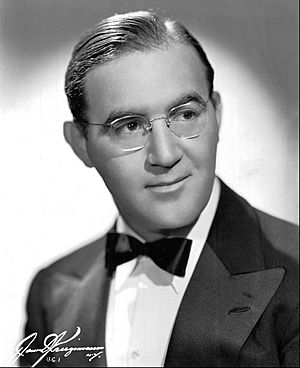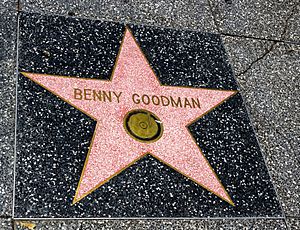Benny Goodman facts for kids
Quick facts for kids
Benny Goodman
|
|
|---|---|

Goodman in 1942
|
|
| Background information | |
| Birth name | Benjamin David Goodman |
| Also known as | "King of Swing", "The Professor", "Patriarch of the Clarinet", "Swing's Senior Statesman" |
| Born | May 30, 1909 Chicago, Illinois, U.S. |
| Died | June 13, 1986 (aged 77) New York City, U.S. |
| Genres | |
| Occupation(s) |
|
| Instruments | Clarinet |
| Years active | 1926–1986 |
| Labels | |
Benny Goodman, born Benjamin David Goodman, (May 30, 1909 – June 13, 1986) was an American jazz musician who played the clarinet. He was called "The King of Swing", "Patriarch of the Clarinet", "The Professor", and "Swing's Senior Statesman".
Contents
Life
Early life
Goodman was the son of poor Jewish immigrants in Chicago, Illinois. They lived in Chicago's Maxwell Street neighborhood. He learned to play clarinet in a boys' band run by a charity. He became a strong clarinet player at an early age, and began playing professionally in bands while still wearing 'in short pants'.
Early influences
His early influences were New Orleans jazz clarinet players in Chicago such as Johnny Dodds, Leon Ropollo, and Jimmy Noone.
First band
Goodman joined one of Chicago's top bands, the Ben Pollack Orchestra, at the age of 16, He made his first recordings with them in 1926. He started making records under his own name two years later.
Later life
Goodman left for New York City. He became a good session musician during the late 1920s and early 1930s. He was known as a solid player because he was prepared and reliable. He played with the nationally known bands of Red Nichols, Isham Jones, and Ted Lewis. Then he formed his own band in 1932.
In 1934, he tried out for the "Let's Dance" radio program. Since he needed new charts every week for the show, his friend John Hammond suggested that he buy some jazz charts from Fletcher Henderson, who had New York's most popular African-American band in the 1920s and early 1930s. The combination of the Henderson charts, his strong clarinet playing, and his band that practiced well made him a rising star in the mid-30s.
Fame
He performed at the Palomar Ballroom in Los Angeles on August 21, 1935. Because of this show, he became known across the United States His radio broadcasts from New York were too late at night for many people on the East Coast to hear them, but Goodman had many fans in California, and a very excited crowd greeted Goodman. This got a lot of attention across the nation, and made the Goodman Band popular very fast. Some writers have said that this was the start of the Swing Era.
Loss of fame
Goodman continued his fast rise throughout the late 1930s with his big band, his trio and quartet, and a sextet. On January 16, 1938, his band made a famous appearance at Carnegie Hall. By the mid-1940s, big bands became less popular. Some reasons for this are that talented musicians were entering the military or getting better-paying factory jobs, gasoline and rubber rationing during WWII, two long musician recording strikes, and the rise of popular singers like Frank Sinatra.
Death
Goodman continued to play on records and in small groups. He would sometimes organize a new band and play in a jazz festival, or go on a tour, playing in other countries. He continued to play the clarinet until he died in 1986 in New York, New York.
Other projects
Goodman also helped racial integration in America. In the early 1930s, black and white jazz musicians could not play together in most clubs or concerts. In the Southern states, racial segregation was enforced by law. Benny Goodman broke with tradition by hiring Teddy Wilson to play with him and drummer Gene Krupa in the Benny Goodman Trio. In 1936, he added Lionel Hampton on vibes to form the Benny Goodman Quartet. Goodman was so famous that his band could afford to not go on tour in the southern states, where the people in his band might have been arrested because of their race.
Awards and honors

Goodman was honored with the Grammy Lifetime Achievement Award.
After winning polls as best jazz clarinetist, Goodman was inducted into the Down Beat Jazz Hall of Fame in 1957.
He was a member of the radio division of the National Association of Broadcasters Hall of Fame.
His papers were donated to Yale University after his death. He received honorary doctorates from Union College, the University of Illinois, Southern Illinois University Edwardsville, Bard College, Brandeis University, Columbia University, Harvard University, and Yale University.
Partial discography
- Swinging 34 Vols. 1 & 2 (Melodeon, 1934)
- Original Benny Goodman Trio and Quartet Sessions, Vol. 1: After You've Gone (Bluebird, 1935)
- Stomping at the Savoy (Bluebird, 1935)
- Air Play (Doctor Jazz, 1936)
- Sing, Sing, Sing (With a Swing) (Columbia, 1937)
- Roll 'Em, Vol. 1 (Columbia, 1937)
- Roll 'Em, Vol. 2 (Columbia, 1937)
- Don't Be That Way (Columbia 1938)
- From Spirituals to Swing (Vanguard, 1938)
- The Famous 1938 Carnegie Hall Jazz Concert Vols. 1–3 (Columbia, 1938)
- Mozart Clarinet Quintet, with the Budapest String Quartet (RCA Victor, 1938)
- Eddie Sauter Arrangements (Columbia, 1940)
- Swing into Spring (Columbia, 1941)
- Benny Goodman Sextet (Columbia, 1944)
- Undercurrent Blues (Capitol, 1947)
- Swedish Pastry (Dragon, 1948)
- Session for Six (Capitol, 1950)
- The Benny Goodman Trio Plays (Columbia, 1951)
- Goodman & Teagarden (Jazz Panorama, 1951)
- Easy Does It (Capitol, 1952)
- Benny at the Ballroom (Columbia, 1955)
- BG in Hi-Fi (Capitol, 1955)
- Mozart Clarinet Concerto with the Boston Symphony Orchestra (1956)
- Mostly Sextets (Capitol, 1956)
- The Great Benny Goodman (Columbia, 1956)
- Peggy Lee Sings with Benny Goodman (Harmony, 1957)
- Benny Rides Again (1958)
- Benny Goodman Plays World Favorites in High Fidelity (1958)
- Benny in Brussels Vols. 1 and 2 (Columbia, 1958)
- In Stockholm 1959 (Phontastic, 1959)
- The Benny Goodman Treasure Chest (MGM, 1959)
- The Hits of Benny Goodman (Capital Records, 1961)
- Benny Goodman in Moscow (RCA Victor, 1962)
- Weber Clarinet Concertos Nos. 1 and 2 with the Chicago Symphony (RCA, 1968)
- London Date (Phillips, 1969)
- Benny Goodman Today (London, 1970)
- This Is Benny Goodman (RCA Victor, 1971)
- Benny Goodman – A Legendary Performer (RCA, 1977)
- Benny Goodman Live at Carnegie Hall: 40th Anniversary Concert (1978)
- Benny Goodman – Live in Hamburg 1981 (Stockfisch, 2019)
Posthumous
- Sing, Sing, Sing (Bluebird, 1987)
- The Benny Goodman Sextet Featuring Charlie Christian: 1939–1941
- 16 Most Requested Songs (Columbia/Legacy, 1993)
- 1935–1938 (1998)
- Carnegie Hall Jazz Concert '38 (1998)
- Bill Dodge All-star Recording (1999)
- 1941–1955 His Orchestra and His (1999)
- Live at Carnegie Hall (1999)
- Carnegie Hall: The Complete Concert (2006)
- The Yale University Music Library, Vol. 2: Live at Basin Street (Musical Heritage Society, 1988)
- The Complete RCA Victor Small Group Recordings (RCA Victor, 1997)
- Lausanne 1950 (Swiss Radio Days Theatre De Beaulieu, May 13, 1950 TCB 2005)
Images for kids
See also
 In Spanish: Benny Goodman para niños
In Spanish: Benny Goodman para niños





